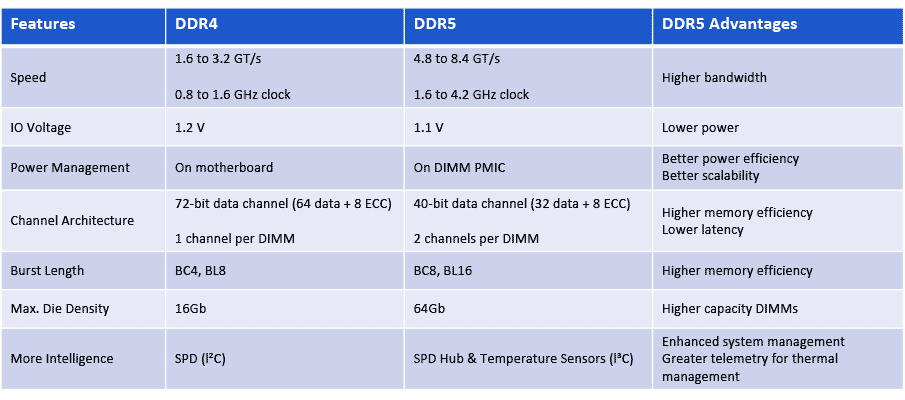DDR5 RAMs were priced over $1,000 at the time of their launch. But a couple of years have passed since then, and in 2023 you can buy DDR5 for under $130. Still, many people are skeptical about the performance of DDR5 vs. DDR4. If you want to upgrade your PC, this article is for you.
We will give you the 5 reasons why DDR5 is better than DDR4. Read on to learn more about the DDR4 vs. DDR5 comparison.
1. Higher Bandwidth
Even the initial DDR5 RAMs have a significantly higher bandwidth than DDR4. The maximum rate at which data can be read from or stored in a DDR4 DIMM is 3.2 giga transfers per second (GT/s). In comparison, the same rate for DDR5 RAM starts at 4.8 GT/s. This means a straightforward increment of 50% in the bandwidth of your RAM.
That’s not all. In the coming days, the bandwidth of DDR5 RAMs will be amped up to 8.4 GT/s. That is 150% more bandwidth than the most advanced DDR4 today. Another important factor associated with bandwidth is the clock rate.
The clock rate is the frequency of data transfer cycles that can be executed. DDR5 is an improvement on DDR4 in terms of clock rate as well. Where DDR4 offers a clock rate between 0.8-1.6 GHz, DDR5 can go up to 4.2 GHz. With this speed, you can say goodbye to lags while advanced gameplay and high-level content creation.
2. Lower Power Consumption
The standard operating voltage for DDR4 RAM was 1.2-1.6 Volts. DDR5 has decreased the voltage requirement to 1.1-1.3 volts. This may not seem like a lot, but it is if you consider the architecture and all the technical improvements DDR5 has to offer. It has improved memory access efficiency, clock rate, and bandwidth while consuming less power.
3. Higher Memory Capacity
4 x 8 GB DDR4 Cards, a total of 32 GB RAM, were enough to build your reputation as a pro gamer among your friends. But what was considered a peak in the past might seem like the surface with the arrival of the all-new DDR5. Currently available DDR5 sticks of 16-32 GB can take the total RAM of a computer with an 8-slot motherboard up to 128-256 GB.
The data packing capacity of DDR5 is likely to increase in the near future up to 128-256 GB per stick. That would make it possible to stack a RAM of up to 2 TB. Right now, RAMs of this size are useless since the supporting hardware isn’t that capable.

Image source: rambus.com
4. Architectural Improvements
There are many differences between DDR4 and DDR5 when it comes to construction. Some of the major ones are channel width, burst length, and the number of output clocks.
DDR4 can accommodate a single channel of 64 bits plus the 8-bit ECC (Error Correction Code), whereas DDR5 comprises dual channels of 32 bits each. The total transfer capacity of memory channels remains the same, but users get efficient and faster access to memory due to the division.
Another significant difference is the burst length. DDR4 had a burst length of 8, while DDR5 extended the burst length to 16. The extended burst length enables memory channels to access 65 bytes of data. This will resolve any underlying speed issues due to cache.
DDR4 RAM has two output clocks on each side of the RCD. On the other hand, DDR5 is equipped with four output clocks on either side. As we know, the function of an RCD is to receive commands from the CPU before passing them to the memory lanes. More output clocks per RCD would result in the smooth execution of simultaneous commands.
All these architectural improvements mean DDR5 is faster and more reliable than DDR4. Plus, the performance of the next generations of DDR5 will unlock the potential of the latest motherboards and processor chips.
5. In-Built Voltage Regulators
A major difference you notice between DDR4 and DDR5 is the location of the power management IC (PMIC). DDR4 uses the PMIC on the motherboard for voltage regulation, whereas DDR5 comes with a PMIC independent of the motherboard.
DDR5 will receive an independent voltage signal of 5V from the motherboard and step it down to 1.1-1.3V. This improves the overall voltage regulation process while keeping the voltage integrity in check. The signal noise is also reduced due to this radical change.
Final Word; DDR4 vs. DDR5; 5 Reasons Why DDR5 is Better Than DDR4
I’ve outlined almost all the major differences between DDR4 and DDR5 RAM. Even in the crude form, DDR5 can outperform any average DDR4 RAM. There is a long way to go for DDR5 RAMs. Manufacturers are yet to unlock the true potential of 5th generation of RAMs.
If you’re into professional gaming or your PC overlocks quite a bit, then DDR5 might be the right choice. You can significantly improve your PC's memory access efficiency and overall performance by switching to DDR5.
If you have any questions about DDR4 vs. DDR5, please direct them to us in the comments below. We would love to respond to your queries.